| Author |
Message |
Jean Henri Chandler

|
 Posted: Fri 14 Sep, 2007 9:01 am Post subject: Posted: Fri 14 Sep, 2007 9:01 am Post subject: |
 |
|
| Nick Trueman wrote: | | I dont believe a mace was beneath any culture, I also dont believe Norse peoples came into any contact with maces during the Viking period. I exclude the Ruso/Norse who traveled into eastern Russia. |
How do you assume that the Ruso / Norse who travelled into eastern Russia, and other places like Byzantium, didn't come into any contact with other Vikings back home or in various other parts of Europe they had colonized? Harald Hardrada was a soldier in the employ of the Byzantines for many years and fought in North Africa, Syria, an Sicily. He most certainly encountered a variety of exotic weapons and armor, and he ended up returning to Norway to become king and then invading England, albiet unsuccessfully 
It's not like the Vikings only went into one zone and never came back. Guys like Gange Rolfe roamed all over nearly the whole extent of Norse infested territories before settling down in Rouen. He could almost as easily ended up in Russia or the Baltic or in Ireland.
Given their vast trade networks, propensity for extremely far-flung foreign adventures, constant fluid, restless movement in this period and their demonstrable readiness, even eagerness to experiment and innovate, I think it's bizarre to assume that the Vikings would have not had awareness of and contact with all kinds of foreign influences or that they would have simply had some kind of ingrained rigid cultural prejudice against them. We also know for certain that they were very quick to adopt foreign cultures from language to dress to quite specificaly military kit. For example Norman heavy Cavalry and Rus horse archers.
Whether or not they had maces is not something I can say but some of these arguments seem to me to have holes in them unless I'm missing something. If they didn't use maces at all I would guess it was due to pragmatic reasons, such as not using cavalry.
I would say the jury is definitely still out, I'm learning a lot here. From Elling Poldens post I've learned that aparently they did use some kind of long hafted mace-like weapon with a stone head called a "Pålstafr".
Thanks for posting those images btw those are fascinating weapons.
J
Books and games on Medieval Europe Codex Integrum
Codex Guide to the Medieval Baltic Now available in print
|
|
  |
 |
Jean Henri Chandler

|
 Posted: Fri 14 Sep, 2007 9:31 am Post subject: Posted: Fri 14 Sep, 2007 9:31 am Post subject: |
 |
|
To put into context what I mean by an infantry vs. a cavalry mace

This is the kind of mace we seem to see in Central Asia in the early Medieval period and the type we are most likely talking about in a Viking context. They are light with a wood haft and usually a small striking head made of what looks like soft iron or bronze usually. Great for a ride-by attack without getting your weapon stuck in the target. Maneuverable and swift to flip around with a thong around your wrist, and quickly dispatch unarmored targets or ring the bell of someone with a helmet. This may actually be a tertiary weapon carried by some very heavily armed warrior who also has a lance or a bow as a primary weapon, plus a sword or a hand-axe as a sidearm, and a lariat, a dagger, and possibly a war-hammer or a few javelins. On the steppe it seemed to be a good thing to have a whole lot of options.

In Europe we eventually started to see weapons like these, which are more evolved for infantry fighting. These are heavier, probably harder, and have more agressive protrusions, and often have langets for protection from being hacked to pieces by an enemies sword or axe, as well as sometimes roundels to protect the hand ...

which evolve into this type which is an ideal infantry mace, much heavier, very hard, pronounced amost axe like flanges, and all metal construction so that they are essentially indestructable. This is more suitible for duking it out toe to toe, i.e. for shock infantry.
The first type of weapon wasn't entirely suitible for the kind of warfare most Vikings engaged in, except perhaps in Russia or possibly places like France. The second type may not have been available or even something they knew about yet, and the third type wasn't around until the Renaissance as far as I know.
J
Books and games on Medieval Europe Codex Integrum
Codex Guide to the Medieval Baltic Now available in print
|
|
  |
 |
Nick Trueman

|
 Posted: Fri 14 Sep, 2007 4:06 pm Post subject: Posted: Fri 14 Sep, 2007 4:06 pm Post subject: |
 |
|
Hi
I dont assume, I go buy what has been found in Nordic and western burials/cremations. If none have been found in a Norse context then we must at this point of time think that they were not used. Until archaeology proves that they did use them than I am not willing to say that the Norse did have them.
The mace on the steppe was a cavalry weapon, and during the early and middle Viking age the Norse were not cavalry at all.
But foot soldiers and probably very good ones at that.
From memory some were found in Gotland? But this is also a late date after the Viking age.
N
"How do you assume that the Ruso / Norse who traveled into eastern Russia, and other places like Byzantium, didn't come into any contact with other Vikings back home or in various other parts of Europe they had colonized?"
|
|
  |
 |
Nick Trueman

|
 Posted: Sat 15 Sep, 2007 6:31 am Post subject: Re: Viking-Rus maces Posted: Sat 15 Sep, 2007 6:31 am Post subject: Re: Viking-Rus maces |
 |
|
Hi Merv
Yeh Id say rope or thick leather thonging? I havent seen any with chain, but they could be out there. I have no Idea how they attached them to a handle, its all speculative.
Gorelik says they are throwing maces, used not so much as killing instrument but some thing too distract, harass and if your lucky maybe knock the target out?
Now this is way out, is there anyone on the forum who has used a ancient sling? What are the chances of being able to loop the mace head through rope and then sling it?
I have know idea, just a thought.
N
| Merv Cannon wrote: | Hi Nick.........Thanks for the pictures ! The first three were tied to the end of a rope much like a flail ? ........ correct me if Im wrong here. I wonder if anyone ( prob. Russians ? ) have reproduced them or train with them as a martial art ?
I have some more pics of them in my files however I have found that in German they just call them "Streitkolben" like all the other maces ( Lit.- Fight-piston ) ....I dont know if they have a separate name ?
There seems to be no shortage of original period small knob-like ones from East European sources........kind of like the Bayeau Tap. ones.
Speaking of the Bayeau Tapestry, the first picture that I posted when I started this topic was of one made here in Oz .....thats what got me started on this whole topic, but I found another reproduced one, just out of interrest, from "Tod's Stuff "in the UK. Its listed as a "Viking or Norman Mace", so I assume hes used the Bayeaux as a guide and assumed the Vikings used it also ? |
|
|
  |
 |
|
C. Gadda
|
 Posted: Sat 03 Jan, 2009 2:22 am Post subject: Posted: Sat 03 Jan, 2009 2:22 am Post subject: |
 |
|
| Christopher Lee wrote: | As for Thor's hammer, perhaps it was recognised as a tool of a blacksmith and that only a warrior of exception skill and strenght could take as mundane an object and turn it to being a weapon of war. There was also a certain mystique associated with the ancient blacksmith's arts, the semi-magical skills of a smith; combining in thor the mystical blacksmith, the warrior and the creator of thunder. As i recall the god vulcan was associated with a hammer and anvil but there is no associated usuage of war hammers or maces amongst the greco-roman world. I know that we are not discussing using blacksmithing hammers as weapons but, and excuse me if i show my ignorance of blacksmithing, but are not the handles of one variety of blacksmithing hammers generally too short to make them an effective weapon while the longer ones would perhaps be too heavy or unbalanced?
I am inclined towards the idea that it was cultural rather than practical considerations in battle than made the mace or hammer unpopular amongst the vikings. |
I am inclined to the opposite conclusion. I have seen this sort of debate elsewhere, and a fundamental point that is left unaddressed is: "How does a warhammer (or mace) fit into the context of Viking warfare - i.e. shield wall combat?" The answer is "not very well." Obviously the primary weapon in such a tactical formation is a spear; even a sword is secondary. Compared to the other secondary weapon, the one handed axe, a war hammer would have all of the disadvantages (unbalanced) but none of the advantages (a cutting edge). Given that the Vikings were not fools, it seems to me that the reason they didn't use a warhammer was because it offered disadvantages rather than advantages.
It is also significant to note that, per Hjalmar Falk's "Altnordische Waffenkunde" there is no word in the Old Norse vocabulary for a "war-hammer" which is a pretty stark proof that none existed. I will have to double check and see if maces are mentioned.
|
|
 |
 |
David Huggins

|
 Posted: Sat 03 Jan, 2009 5:45 am Post subject: Viking maces Posted: Sat 03 Jan, 2009 5:45 am Post subject: Viking maces |
 |
|
Just chipping in here guys, without reading through the whole of this thread so shoot me down if I am mentioning anything already covered.
From my own experiance with re-enactment viking age axe heads, some axe heads have a hammer projection opposite to the blade, and these hammer projections make for very effective use when combined with the axe blade, acting exactly with the same blunt trauma effect that a mace would have.
The previking age Sutton Hoo axe hammer stands out as well, but having handled a reproduction, and I think that I would agree with fellow forumite Paul Mortimer, who thinks it may have been symbolic rather then an actual weapon, to wield it as a weapon due to its considerable head heavy weight with one hand would require some exceptional and considerable strength.
I like the idea of it been used for ritual purposes, dispatching large animal sacrifices using a two handed grip, this would concur with it being a symbolic object of Kingship.
Dave
and he who stands and sheds blood with us, shall be as a brother.
|
|
   |
 |
James Aldrich

Location: Green Bay WI Joined: 21 Aug 2003
Posts: 112
|
 Posted: Sat 03 Jan, 2009 6:46 am Post subject: Posted: Sat 03 Jan, 2009 6:46 am Post subject: |
 |
|
This may be stretching the topic a bit but there is something I have always been curious about: In reading Old English works I find two words, sweord and mece, both translated as "sword." I have asked three professors about the possible distinction between the two Old English words and none was able to provide any insight. Any thoughts from this forum?
JSA
|
|
   |
 |
|
Mikael Ranelius
|
 Posted: Sat 03 Jan, 2009 9:16 am Post subject: Re: Viking-Rus maces Posted: Sat 03 Jan, 2009 9:16 am Post subject: Re: Viking-Rus maces |
 |
|
| Merv Cannon wrote: |  |
Interesting, there's at least one similar mace head of bronze found in Sweden, it is however dated as "medieval":

|
|
  |
 |
|
Mikael Ranelius
|
 Posted: Sat 03 Jan, 2009 9:36 am Post subject: Posted: Sat 03 Jan, 2009 9:36 am Post subject: |
 |
|
As for the original question, I've searched the SHM database and found a few of these "crowned" maces, all of them are from Gotland and are dated to the middle ages:
 Attachment: 17.55 KB Attachment: 17.55 KB
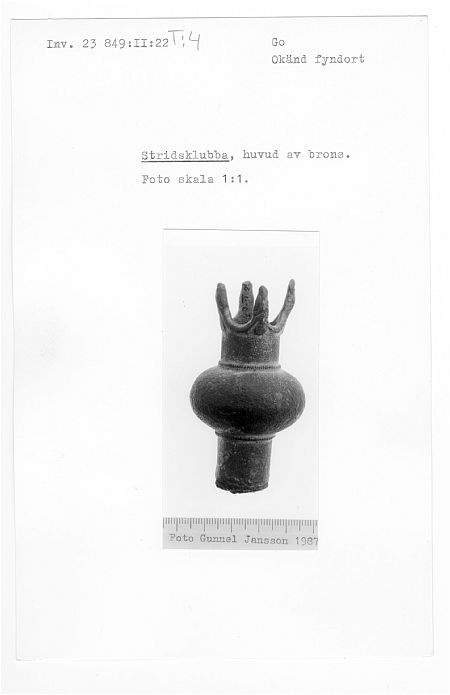
 Attachment: 15.8 KB Attachment: 15.8 KB
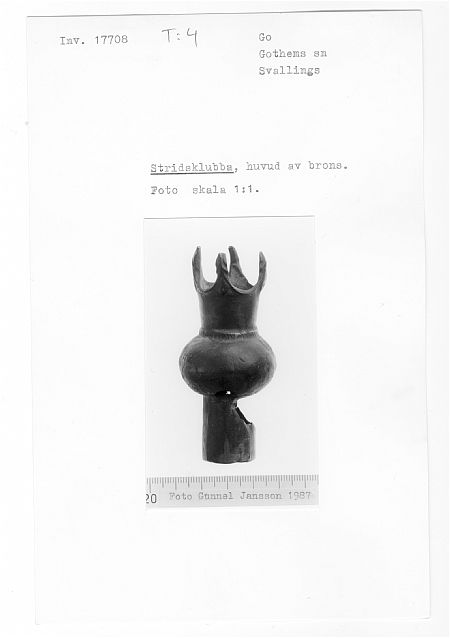
 Attachment: 14.5 KB Attachment: 14.5 KB
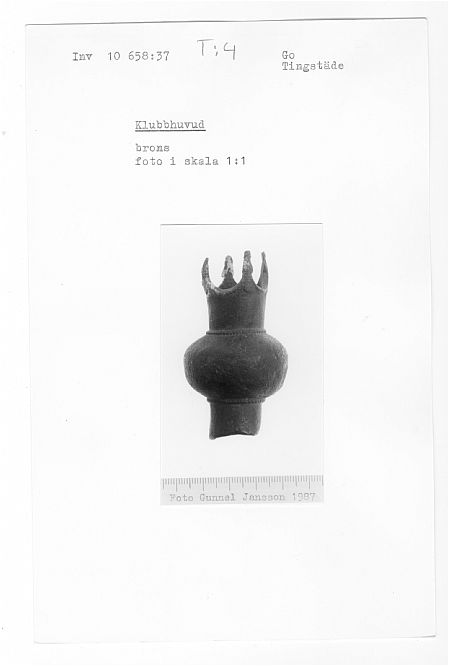
 Attachment: 18.16 KB Attachment: 18.16 KB
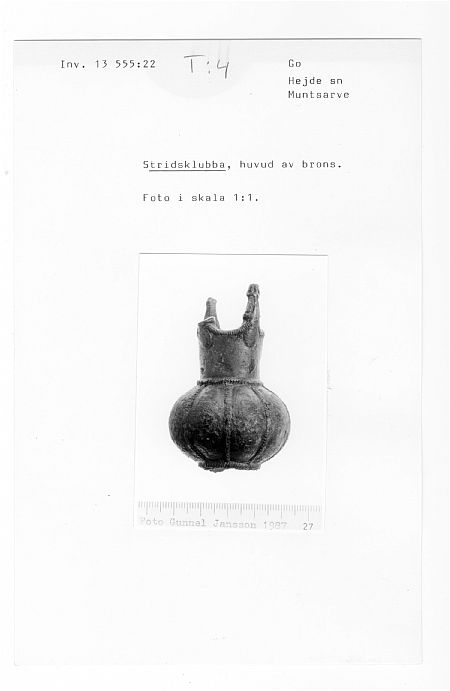
|
|
  |
 |
|
Andres M. Chesini Remic
Location: Buenos Aires, Argentina Joined: 17 Dec 2008
Posts: 33
|
 Posted: Sun 04 Jan, 2009 5:00 pm Post subject: Posted: Sun 04 Jan, 2009 5:00 pm Post subject: |
 |
|
| Dave Womble wrote: | | The viking age did NOT last until the 1200s, no matter where you're looking. |
Still, the Orkneyinga saga states there were Jarls "sailing viking" in such late ages as 1240....
The most usual is taking lindisfarne and hastings (or stamford) as the limits, but people at that time though it was different...
Anyway, let's concentrate in the 8th to 11th century period...
Even if know Graham-Campbell's book, I don't own it, and I don't know of any archeological site called "Narrkvia" in Grotlingbo.
The closest I can recall, is Narrland (also in Gotland), where a stone mace of the viking age was found....
I'll see if I can find a pic, and I'll upload it. It's rather small (about 5cms), but still a mace...
Greetings
"El que no viene por donde debiera, no viene a lo que dice - P. B. Palacios ~ Almafuerte"
|
|
     |
 |
|
Len Parker
|
 Posted: Mon 07 May, 2012 5:48 am Post subject: Posted: Mon 07 May, 2012 5:48 am Post subject: |
 |
|
War clubs in Saxo's History of the Danes http://www.sacred-texts.com/neu/saxo/saxo07.htm
...and when he heard that Erik's champion, Hakon, was skillful in blunting swords with his spells, he fashioned, to use for clubbing, a huge mace studded with iron knobs, as if he would prevail by the strength of wood over the power of sorcery. Then -- for he was conspicuous beyond all others for his bravery -- amid the hottest charges of the enemy, he covered his head with his helmet, and, without a shield, poised his club, and with the help of both hands whirled it against the bulwark of shields before him. No obstacle was so stout but it was crushed to pieces by the blow of the mass that smote it."
"And while he chanced to be walking through a shady woodland, he plucked up by the roots all oak that stuck in his path, and, by simply stripping it of its branches, made it look like a stout club. Having this trusty weapon, he composed a short song as follows:
"Behold! The rough burden which I bear with straining crest, shall unto crests bring wounds and destruction. Never shall any weapon of leafy wood crush the Goths with direr augury. It shall shatter the towering strength of the knotty neck, and shall bruise the hollow temples with the mass of timber. The club which shall quell the wild madness of the land shall be no less fatal to the Swedes. Breaking bones, and brandished about the mangled limbs of warriors, the stock I have wrenched off shall crush the backs of the wicked, crush the hearths of our kindred, shed the blood of our countrymen, and be a destructive pest upon our land."
When he had said this, he attacked Siwald and his seven sons, and destroyed them, their force and bravery being useless against the enormous mass of his club.
|
|
  |
 |
|
Ryan S.
|
 Posted: Mon 07 May, 2012 4:29 pm Post subject: Posted: Mon 07 May, 2012 4:29 pm Post subject: |
 |
|
if this is a weapon what is the purpose of the crown? As far as adopting foreign weapons and battle techniques, there is a reason why there are major differences between Scandinavian culture and the various places they visited. Today, there are a variety of symbols of authority that could be derived from a club. Sceptres represent the authority of the holder, but most of them represent delegated authority. For example, marshal's batons and steward's wands, not to mention the maces that are present in many legislatures.
I gather from what people have said here that the mace was not a standard weapon of the Viking s. If it is a sceptre then I would expect to see it in depictions of Kings. As far as the Bayeux tapestry, The Study of the Bayeux Tapestry
By Richard Gameson, describes both William and Odo as having maces, as well as a different staff (baculum), that is purely a symbol and not a weapon. Since both brothers have it, perhaps it is the predecessor of the Marshall's baton. Of course, the Conquer was Norman, and more Latinized than the Vikings.
So if the Vikings didn't use them in warfare, what did they use them for? The crown suggests that they weren't reserved for thralls, and if a wide spread symbol of authority, why weren't they in burials? Perhaps they were weapons carried for everyday protection, as oppose to war. A viking can carry a spear every where, and not everyone had swords.
here is some info on Byzantine maces that could be thrown.
http://www.worldmuseumofman.org/byzrommace.php
|
|
  |
 |
Elling Polden

|
 Posted: Mon 07 May, 2012 5:39 pm Post subject: Posted: Mon 07 May, 2012 5:39 pm Post subject: |
 |
|
The Gotland maces are medevial, and probably of slavic origin.
At least in Norway, the traditional power symbol is an axe. In some early medevial texts, an axe is described as the heraldric mark of the Norwegian kings, along with a Rampant Lion. From the 1270s it is a Rampant Lion WITH an axe.
There are refrences to clubs, as Len posts above, but metal head maces do not appear before the middle ages, as far as I know.
Just hit those uppety thralls with the back of the axe. Works like a charm. (all free men that where not actively poor where required to own an axe or sword from the 950s onward. The tradition of carrying them to show status stuck until the 18th century)
By the way; A long hafted mace will fly wonderfully when thrown like a javelin. The heavy head makes it a lot more stable than a spear.
"this [fight] looks curious, almost like a game. See, they are looking around them before they fall, to find a dry spot to fall on, or they are falling on their shields. Can you see blood on their cloths and weapons? No. This must be trickery."
-Reidar Sendeman, from King Sverre's Saga, 1201
|
|
    |
 |
|
William P
|
 Posted: Mon 07 May, 2012 8:16 pm Post subject: Re: Viking-Rus maces Posted: Mon 07 May, 2012 8:16 pm Post subject: Re: Viking-Rus maces |
 |
|
| Mikael Ranelius wrote: | | Merv Cannon wrote: | 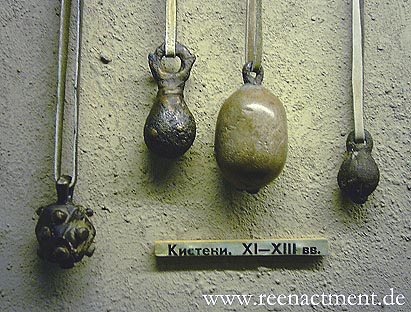 |
Interesting, there's at least one similar mace head of bronze found in Sweden, it is however dated as "medieval":
 |
umm those are flails. yu can tell because of the loop on the top, the flails of the early medieval rus didnt use chains, instead using leather thongs.
the works of A N kirptchnikov detail more about the flails used by the rus
and 115 grams of lead was enough to make a huge dent in a cconut that woud kill a man almst instantly and most of the bronze weghts also weighed about 11-150 grams.
also as for the badge of rank thing, in japan the sai and jutte were also symbols of being police chiefs. it was ALSO their weapon of choice.and a very effective one at that those small maces could and would still break a wrist or concuss someone when swung.
|
|
   |
 |
|
Ryan S.
|
 Posted: Mon 07 May, 2012 10:22 pm Post subject: Posted: Mon 07 May, 2012 10:22 pm Post subject: |
 |
|
| Elling Polden wrote: | The Gotland maces are medevial, and probably of slavic origin.
At least in Norway, the traditional power symbol is an axe. In some early medevial texts, an axe is described as the heraldric mark of the Norwegian kings, along with a Rampant Lion. From the 1270s it is a Rampant Lion WITH an axe.
There are refrences to clubs, as Len posts above, but metal head maces do not appear before the middle ages, as far as I know.
Just hit those uppety thralls with the back of the axe. Works like a charm. (all free men that where not actively poor where required to own an axe or sword from the 950s onward. The tradition of carrying them to show status stuck until the 18th century)
By the way; A long hafted mace will fly wonderfully when thrown like a javelin. The heavy head makes it a lot more stable than a spear. |
isn't the axe in the Norwegian coat of arms, the instrument of St. Olav's martyrdom?
|
|
  |
 |
|
Len Parker
|
 Posted: Tue 08 May, 2012 5:32 am Post subject: Posted: Tue 08 May, 2012 5:32 am Post subject: |
 |
|
Elling, I just read this in Saxo:
The hero Gram makes a special mace:
Having heard from the diviners that Sigtryg could only be conquered by gold, he straightway fixed a knob of gold to a wooden mace, equipped himself therewith in the war wherein he attacked the king, and obtained his desire. This exploit was besung by Bess in a most zealous strain of eulogy:
"Gram, the fierce wielder of the prosperous mace, knowing not the steel, rained blows on the outstretched sword, and with a stock beat off the lances of the mighty. http://www.sacred-texts.com/neu/saxo/saxo01.htm
Gram is the son of Skjold mentioned in Beowulf, which would make this pre-viking age.
The problem with Saxo and the Icelandic sagas is not knowing whether the writers are handing down stories unchanged, or possibly introducing new customs and fashions into the old stories. Certainly the Arthurian tales and the Sigfried and Brunhild legends were constantly being updated in every century.
|
|
  |
 |
Elling Polden

|
 Posted: Tue 08 May, 2012 12:41 pm Post subject: Posted: Tue 08 May, 2012 12:41 pm Post subject: |
 |
|
| Ryan S. wrote: |
isn't the axe in the Norwegian coat of arms, the instrument of St. Olav's martyrdom? |
According to the sagas, he was first axed above the knee, then thrust with a spear and finaly struck by a sword. He is frequently shown armed with an axe in the battle, as well.
"this [fight] looks curious, almost like a game. See, they are looking around them before they fall, to find a dry spot to fall on, or they are falling on their shields. Can you see blood on their cloths and weapons? No. This must be trickery."
-Reidar Sendeman, from King Sverre's Saga, 1201
|
|
    |
 |
|
|
You cannot post new topics in this forum
You cannot reply to topics in this forum
You cannot edit your posts in this forum
You cannot delete your posts in this forum
You cannot vote in polls in this forum
You cannot attach files in this forum
You can download files in this forum
|
All contents © Copyright 2003-2024 myArmoury.com — All rights reserved
Discussion forums powered by phpBB © The phpBB Group
Switch to the Basic Low-bandwidth Version of the forum
|

